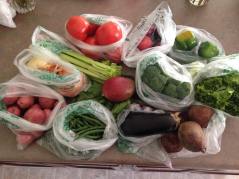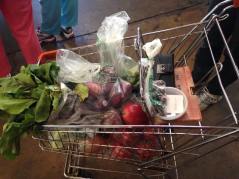Blog Archives
Easy Ways to Eat Healthy
Posted by K.M.H
One of the things that Erin and I try really hard to do is eat healthy.
I use to think of eating healthy as buying all that stuff out there that claimed that it was “healthy food.” Things that were quick and easy, but still technically good for you. Baked chips or those Healthy Choice microwavable meals or vegetable smoothie drinks.
But then I actually looked at what I was eating, and I don’t mean just the nutrition label, but the ingredients label as well. And not only did I realize that in some of the things I was consuming had so much salt or sugar that it was borderline dangerous to eat on a regular basis, but some of the ingredients weren’t even actual food items. They were chemicals or dyes or extracts, and I thought, Wow, this can’t be *that* good for me if it’s not even *real* food.
So how do you determine what’s healthy food without doing any kind of extensive research? And how do you afford to pay for all of this because healthy eating can be expensive?
I started doing some research, and I read something that completely changed my entire thinking when it came to determining what was healthy and what wasn’t healthy:
If you want to eat healthy, shop the edge of the store.
Think about it: when you walk into a grocery store, chances are the bakery, deli, produce, seafood, meat, and dairy sections are all on the outside edges of the store. All that food tends to be what professionals consider “whole foods” instead of processed foods.
We, as Americans, are so tied to convenience and things being easy, that it’s almost like we’re hardwired to not want healthy foods because it takes more than a microwave and five minutes to prepare. If there’s one thing I’ve learned about healthy eating is that you have to be willing to put the time into making it happen. Ready-to-eat items are ALMOST always not healthy. This includes canned fruits and veggies (mostly due to preservatives and the chemicals) and frozen or heat-up meats.
When it comes to things on the aisles of the grocery store, they’re almost always “processed foods” in some way. They’re in boxes or cans and filled with preservatives to keep them fresher longer or prepared in some way making them ready to eat after being heated up or some other quick, small step. To eat healthy, simply avoid the aisles of the grocery store as much as possible.
For Erin and I, we shop the aisles for the following items only:
- Whole wheat or veggie pasta (until we figure out how to make our own, which is on our list of things to start doing at some point)
- Brown rice
- Flour, sugar, baking needs
- Sauces, syrups, seasonings (like dressings or Erin’s white sauce or chocolate 50% less sugar syrup or 100% real maple syrup or that poultry spice I put on everything that once had wings. We make our own tomato sauce now)
- Frozen fruit (for smoothies)
- Peanut butter/jelly/jam (but only the low sugar and organic/natural brands; if the peanut butter doesn’t have to be stirred and refrigerated, we don’t buy it)
- The occasional bag of chips or soda (we’re talking 3 or 4 times a year and usually only when there’s an event happening)
That’s honestly all I can think about that we get from the aisles of the store on a regular basis (which isn’t that regular, really).
Everything else, from spaghetti sauce to soups to thai food and beyond, we make ourselves.
Never Under Estimate the Power of a Freezer or the Ability to Freeze Food.
Erin and I will spend a weekend every so often cooking. We’ll cook everything you could possibly imagine, and we won’t eat a single bite of it. Like today, I’m going to be making a huge order of biscuits so that the buttermilk we have won’t go to waste. (We needed 1/3 of a cup for dinner last night and they were only selling it in half gallons at the store.)
The other weekend, Erin made a huge pot of tomato sauce and sectioned it off into two person servings and then put it in the freezer. Earlier this week, I made a huge pot of curried tofu and managed to get four two-person servings out of it and froze it. I’ve also got two or three containers of butternut squash soup in the freezer, and Erin has some froze broccoli stems for when she makes broccoli and cheese soup sometime in the near future. We’ll make pancakes, waffles, biscuits and other breakfast meals at night, cool them, and freeze them so in the mornings when we want to, we just pull out what we want and put it in the oven or toaster to heat it up.
We then control what goes into them. We can use whole wheat flour or substitute butter and sugar for whatever we want to make toaster waffles and pancakes and all that more healthy. We can buy organic or local veggies for our soups and sauces. We can also control portion size and make them bigger or smaller depending on our wants or needs. But it takes time.
And space. We desperately want a larger freezer. One of those that we could put in the basement or the garage to store our frozen food items more so.
But… The cost has to be insane.
Actually, we spend less on food now than we did. And our biggest budget buster with food is when we go out to eat. We honestly spend about $90 to $100 on food every month and $150 to $200 on food every three to four months (when we need meat).
We shopped around, and stopped buying produce in a grocery store. We went to two or three different farmer’s markets and vegetable stands until we found a place we liked, with good prices and good product. The one we chose is a little far out, but it’s right next to our church, so we go out there on Sundays after church.
Look at these pictures:
This isn’t a full sized shopping cart, but it isn’t a super small one either. Every other week, Erin and I fill this sucker up with fresh veggies and fruit from our veggie stand and we take no more than $40 with us when we go. This shopping trip above included the following:
- 1.5+ lbs of potatoes
- 1+ lb of green beans
- an eggplant
- 3 large beets
- 1 head of green leaf lettuce
- a mango
- a broccoli bunch
- 3 large onions
- 5 large tomatoes
- 1 celery bunch
- 2 green bell peppers
- 5 plums
Total cost? $23.xx
The most we have ever spent was $27.xx because we bought apples off season. This amount of veggies will feed us for two weeks with a few extras added on after a week (usually costing no more than $10).
I did a price check on this same amount of vegetables at the grocery store, and it was pushing closer to $30 to $35 bucks, and the only reason it cost that little was because some of the veggies were on sale that week.
The next thing we did was purchase a membership to a local wholesaler, specifically Costco. We get our almond milk, butter, hummas, avocados (which we eat in bulk), small tomatoes on the vine, mushrooms, and meat.
Meat is expensive. And it’s so easy to freeze. We buy it in bulk and then don’t pay for it for months on end. This is why our food bill goes up every four or so months: we have run out of meat.
We’ll get ground turkey, bison, chicken, fish (salmon, catfish, others), shrimp. The portions in Costco are huge, so we’ll buy a huge filet of salmon, and I’ll come home and cut it into serving sizes for us, wrap it in foil and put it in a freezer bag. I do the same thing with anything else that needs to be portioned out (like if we have breakfast sausages, I’ll portion them out in groups of two so that they can be easily heated up in the morning).
Any other random stuff we need, we will get at the grocery store. We buy our bread fresh from the bakery because they don’t use preservatives to keep it from going bad, and we’ll put it in the fridge. It’s slightly more expensive, but since we’re saving elsewhere, we can afford to do it.
For the most part, Erin and I have set and met our goal of only buying and eating whole foods. The cost hasn’t been so much of an issue as much as making the commitment to prepare the food we buy, which can be time consuming. I, personally, think that’s the greater issue with eating healthy. It’s not so much the affordability as being able to dedicate the time to actually cooking instead of simply heating up.
And if you’re looking to make the change to healthier food, that’s really the first question you need to ask yourself: Am I willing to dedicate the time to cooking that I need to so that I can have a more healthy diet. If the answer is yes, then you’ll not only potentially save money, but you’ll be a more healthy version of yourself.
Posted in Random Rants
Tags: diet, farmer's market, food, fruit, healthy buying, healthy eating, saving, vegetable, vegetable stand, veggies









You must be logged in to post a comment.